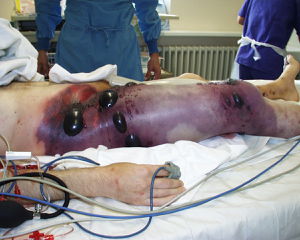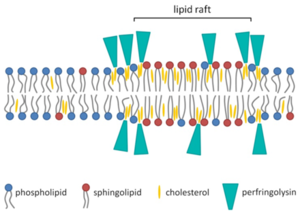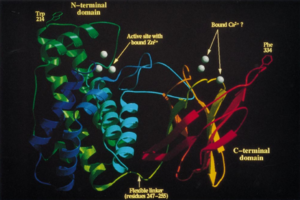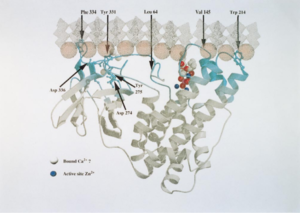Gas gangrene (Clostridial myonecrosis): Difference between revisions
No edit summary |
No edit summary |
||
| Line 13: | Line 13: | ||
[[Image:alphatox1.png|thumb|300px|right|Alpha-toxin shown interacting with lipid bilayer of eukaryotic membrane. Interactions with ions are shown, denoting the critical role of Ca2+ and Zn2+ in the function of alpha-toxin. [http://ac.els-cdn.com/S1075996499901919/1-s2.0-S1075996499901919-main.pdf?_tid=843ae610-28a7-11e7-a31e-00000aacb35e&acdnat=1493008740_a6dead265896beb6ba4f37cf4b555556 ].]] | [[Image:alphatox1.png|thumb|300px|right|Alpha-toxin shown interacting with lipid bilayer of eukaryotic membrane. Interactions with ions are shown, denoting the critical role of Ca2+ and Zn2+ in the function of alpha-toxin. [http://ac.els-cdn.com/S1075996499901919/1-s2.0-S1075996499901919-main.pdf?_tid=843ae610-28a7-11e7-a31e-00000aacb35e&acdnat=1493008740_a6dead265896beb6ba4f37cf4b555556 ].]] | ||
[[Image:oxygen.png|thumb|300px|right|Use of hyperbaric oxygen therapy in wound healing of 53-year-old diabetic patient with spontaneous gas gangrene. Leg was preserved with use of hyperbaric oxygen. Healthy tissue growth can be seen last image. [ | [[Image:oxygen.png|thumb|300px|right|Use of hyperbaric oxygen therapy in wound healing of 53-year-old diabetic patient with spontaneous gas gangrene. Leg was preserved with use of hyperbaric oxygen. Healthy tissue growth can be seen last image. [http://www.ijps.org/article.asp?issn=0970-0358;year=2012;volume=45;issue=2;spage=316;epage=324;aulast=Bhutani].]] | ||
<br>By Yiyi Ma<br><br> | <br>By Yiyi Ma<br><br> | ||
Revision as of 05:01, 24 April 2017
Section

By Yiyi Ma





By Yiyi Ma
Introduction starts here
At right is a sample image insertion. It works for any image uploaded anywhere to MicrobeWiki.
The insertion code consists of:
Double brackets: [[
Filename: PHIL_1181_lores.jpg
Thumbnail status: |thumb|
Pixel size: |300px|
Placement on page: |right|
Legend/credit: Electron micrograph of the Ebola Zaire virus. This was the first photo ever taken of the virus, on 10/13/1976. By Dr. F.A. Murphy, now at U.C. Davis, then at the CDC.
Closed double brackets: ]]
Other examples:
Bold
Italic
Subscript: H2O
Superscript: Fe3+
Introduce the topic of your paper. What is your research question? What experiments have addressed your question? Applications for medicine and/or environment?
Sample citations: [1]
[2]
A citation code consists of a hyperlinked reference within "ref" begin and end codes.
Section 1
Include some current research, with at least one figure showing data.
Every point of information REQUIRES CITATION using the citation tool shown above.
Section 2
Include some current research, with at least one figure showing data.
Section 3
Include some current research, with at least one figure showing data.
Section 4
Conclusion
References
Authored for BIOL 238 Microbiology, taught by Joan Slonczewski, 2017, Kenyon College.
